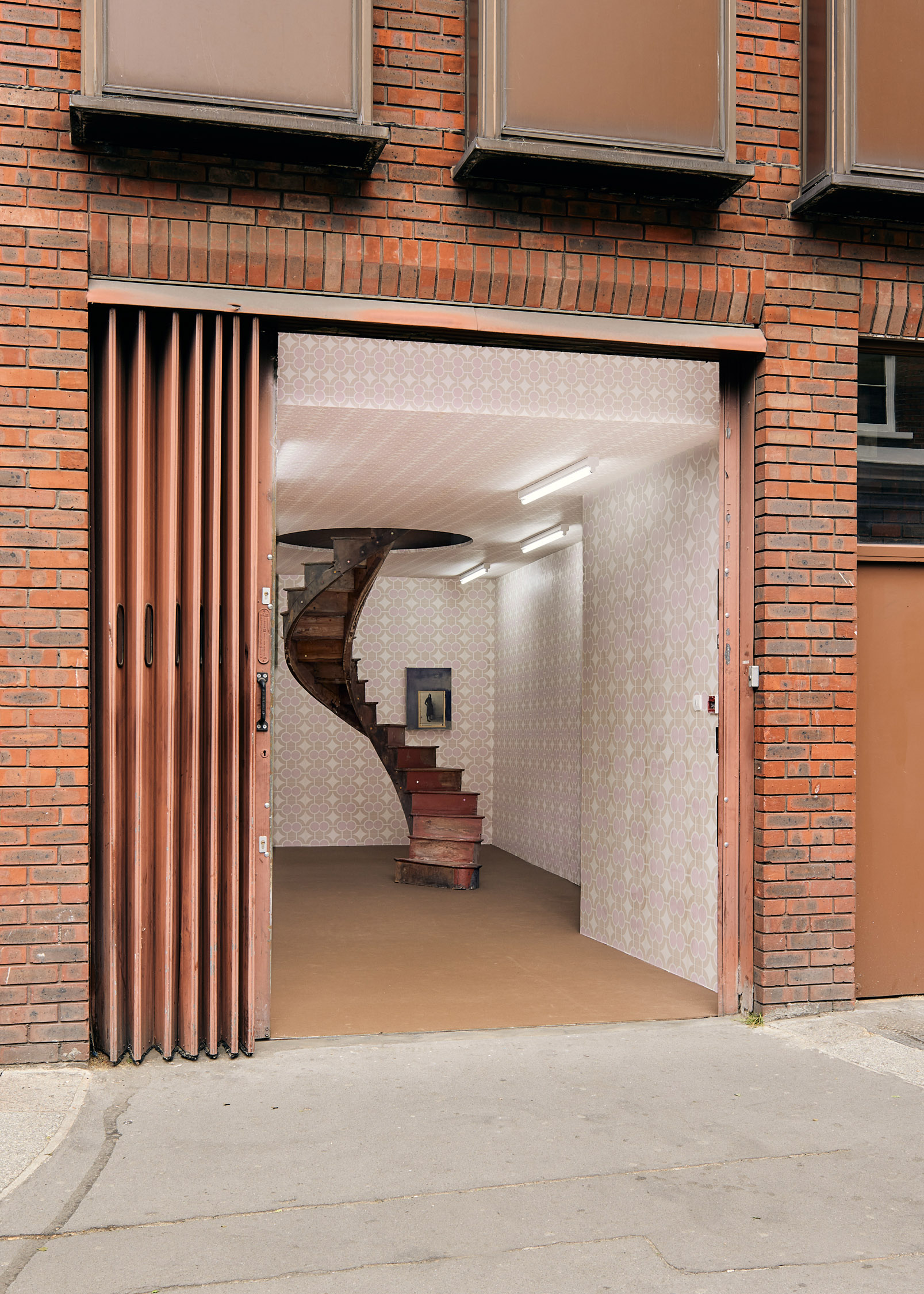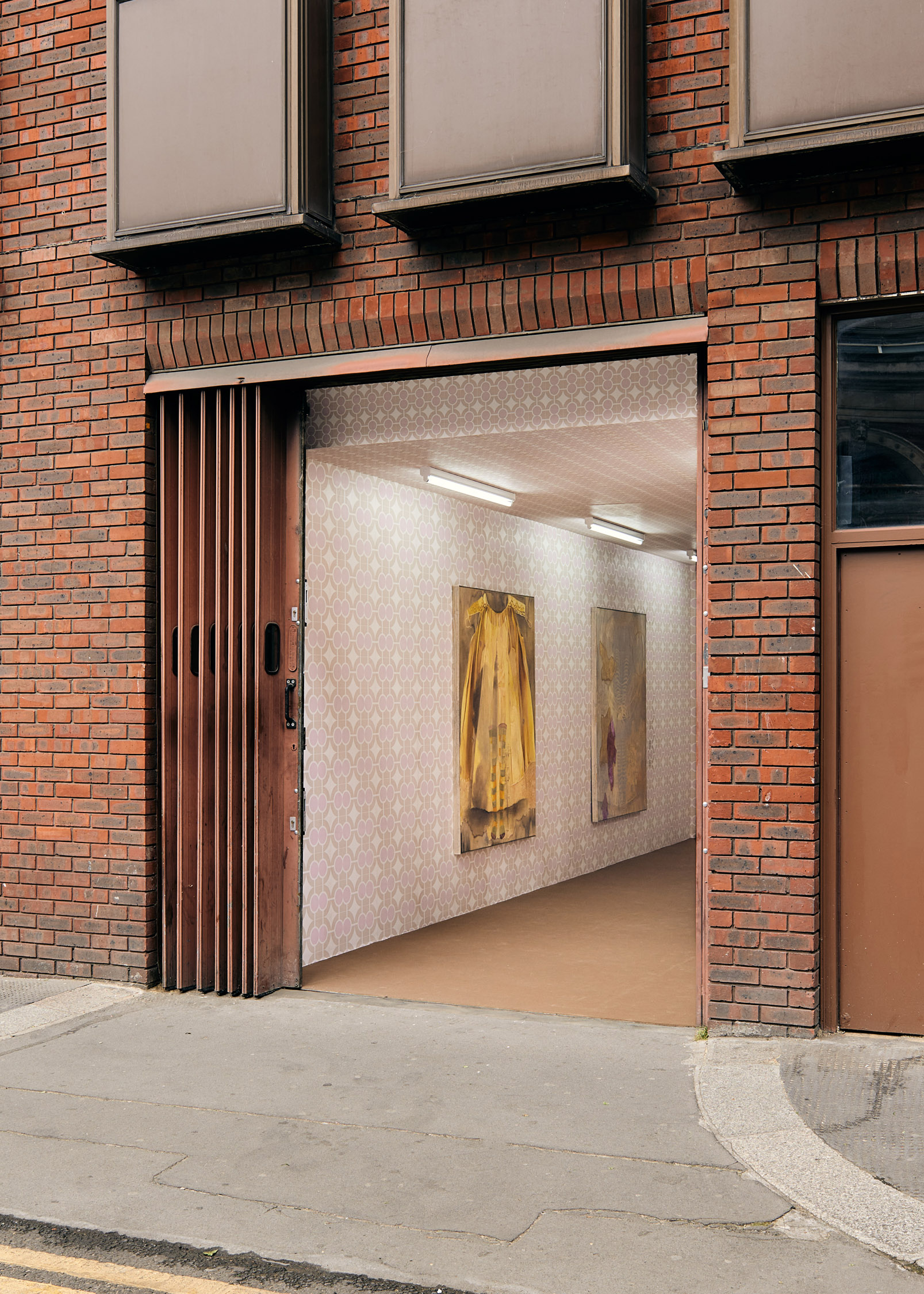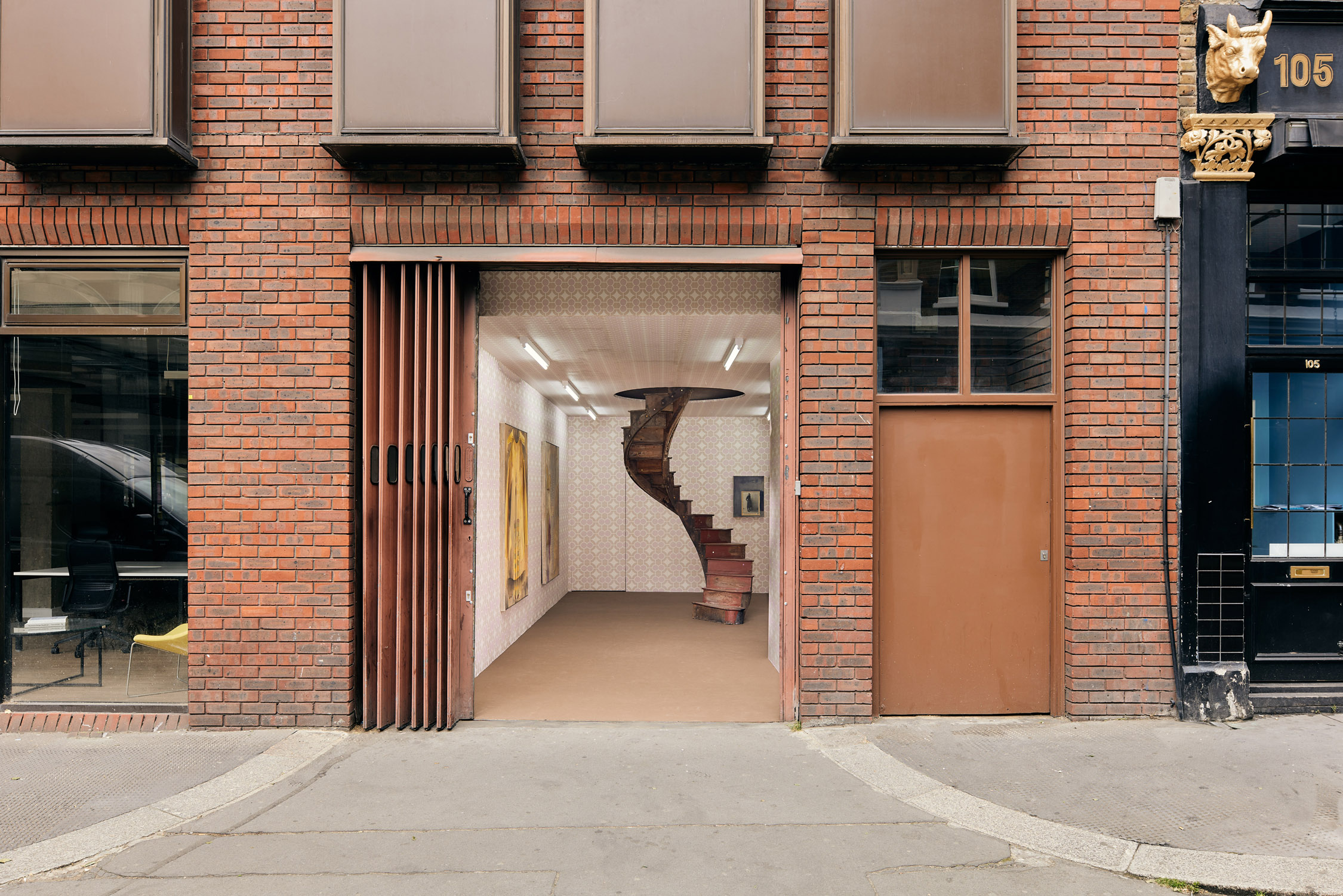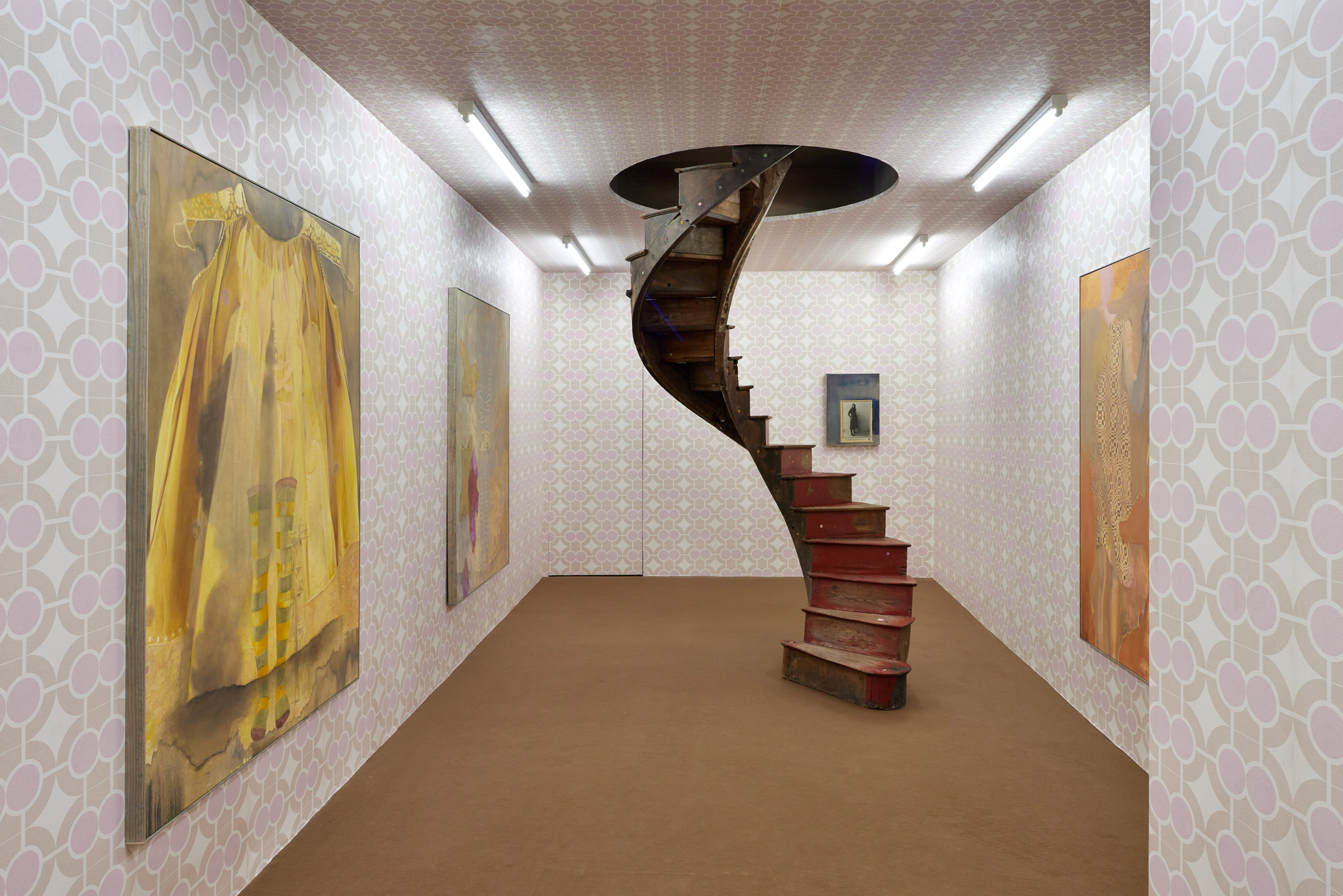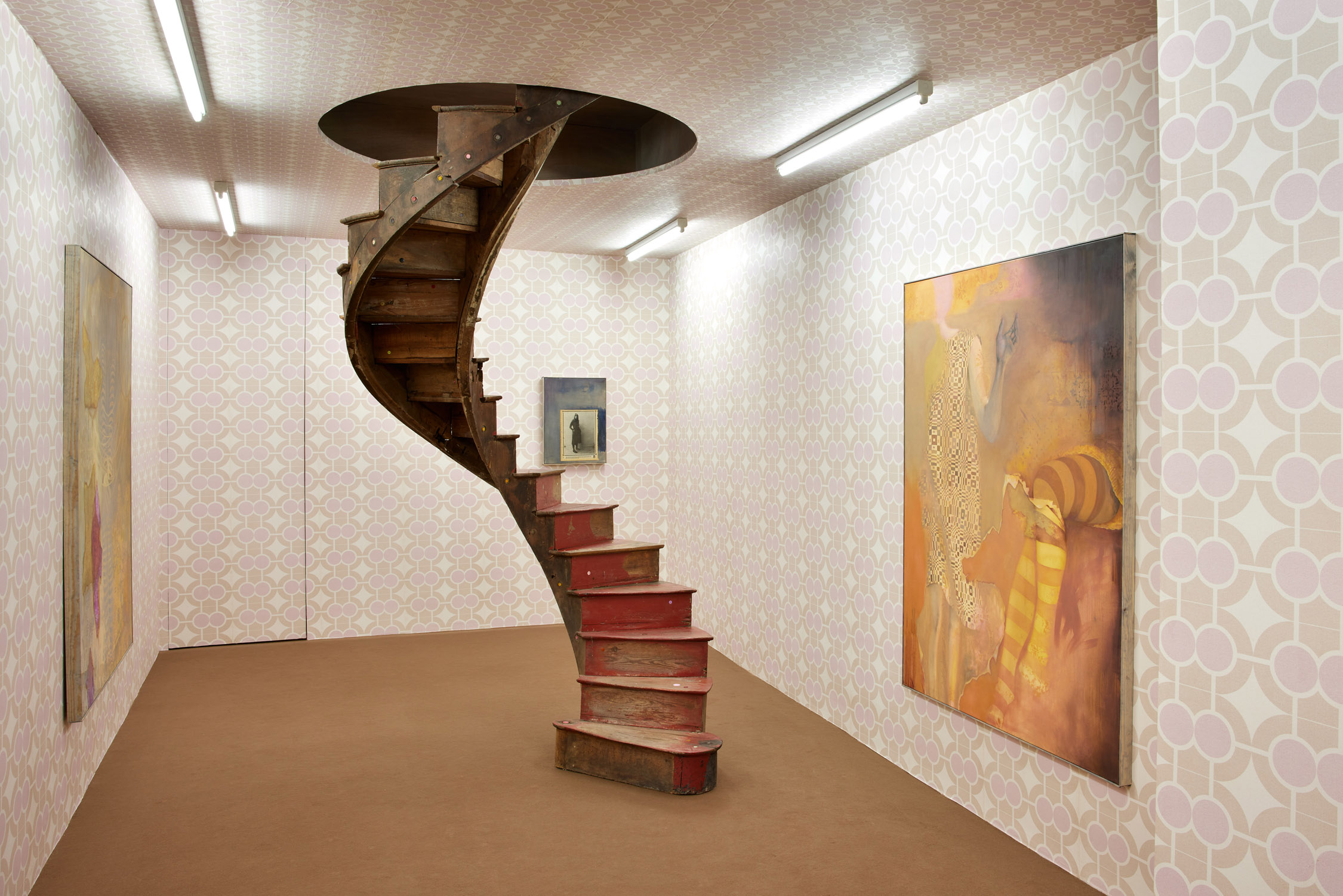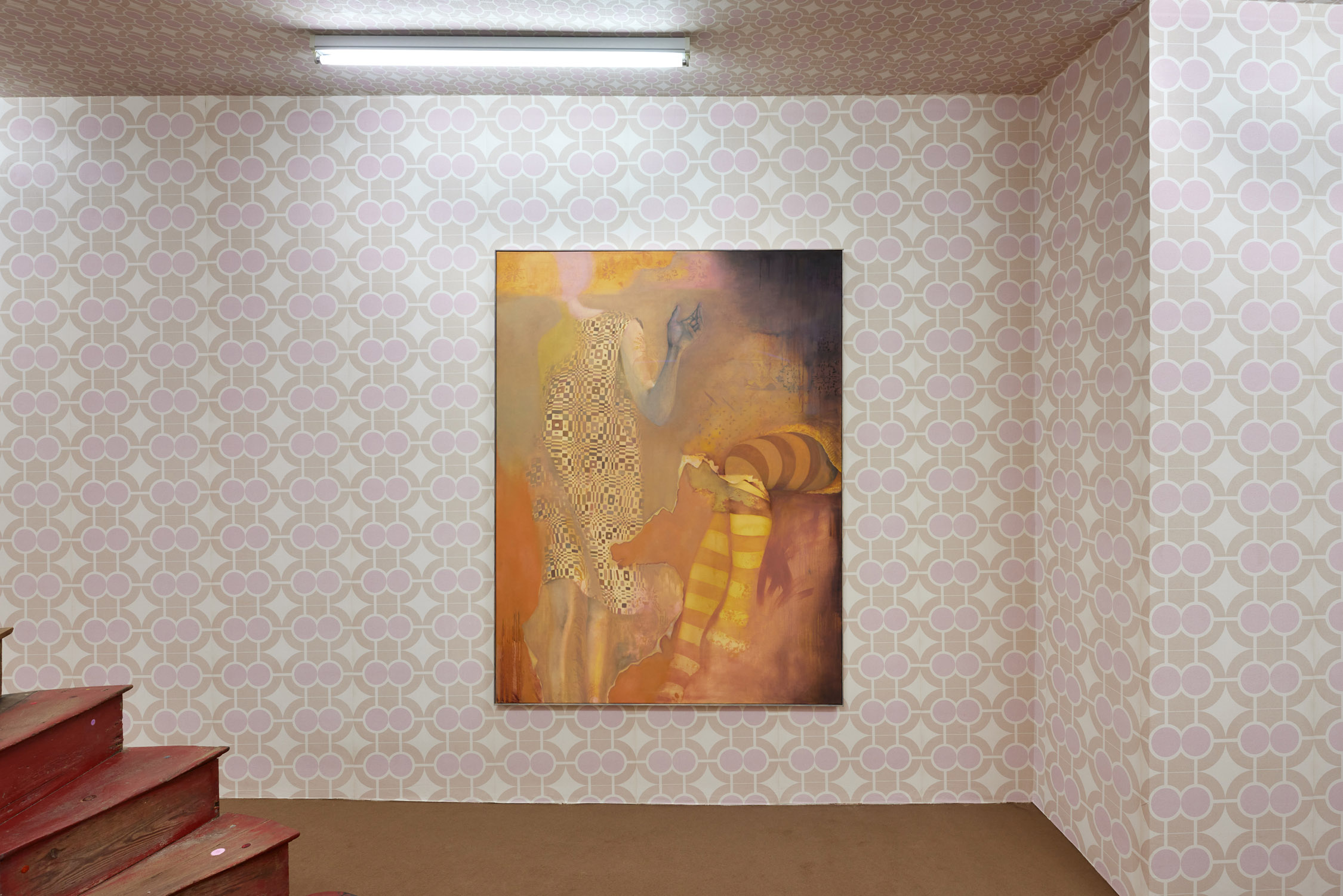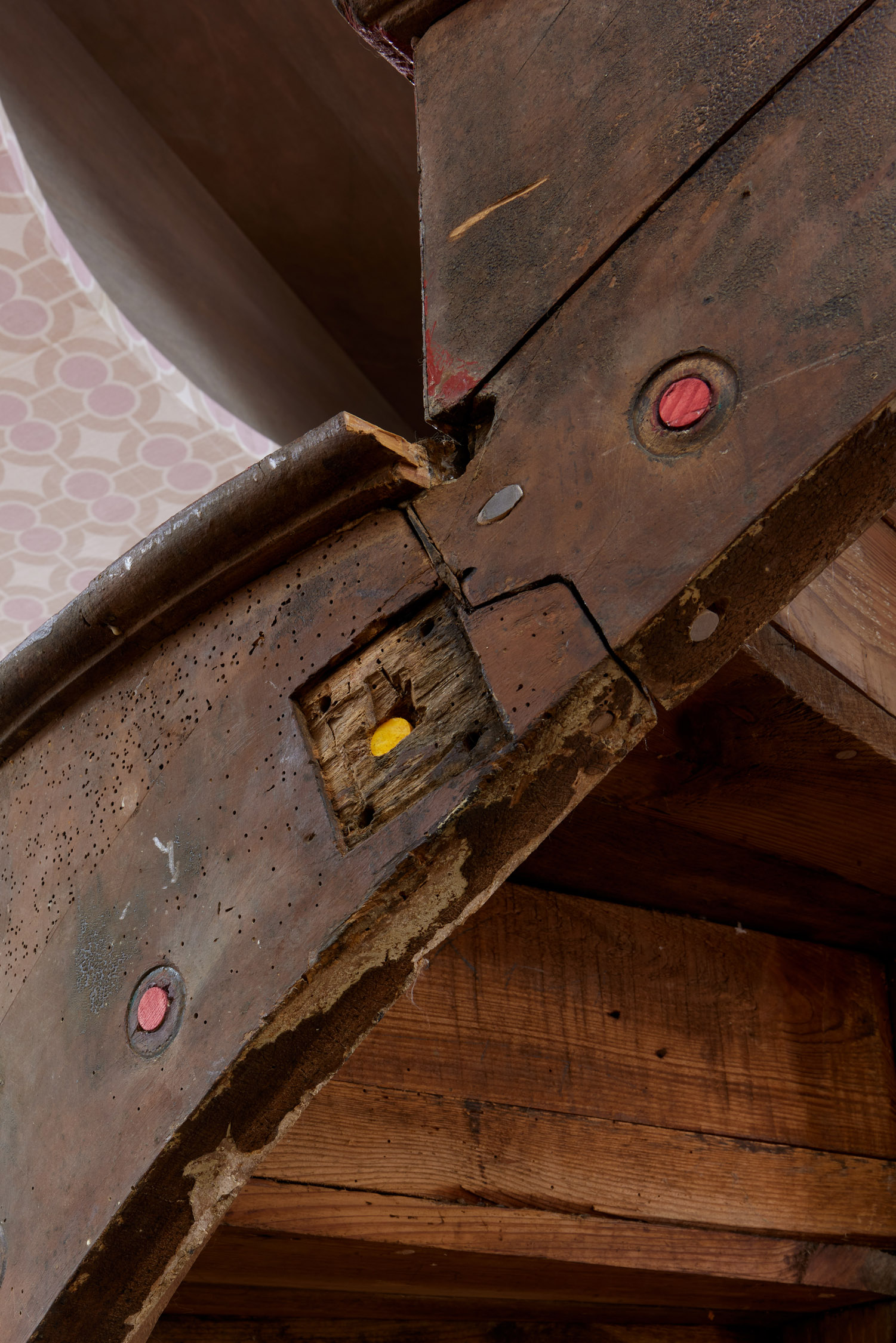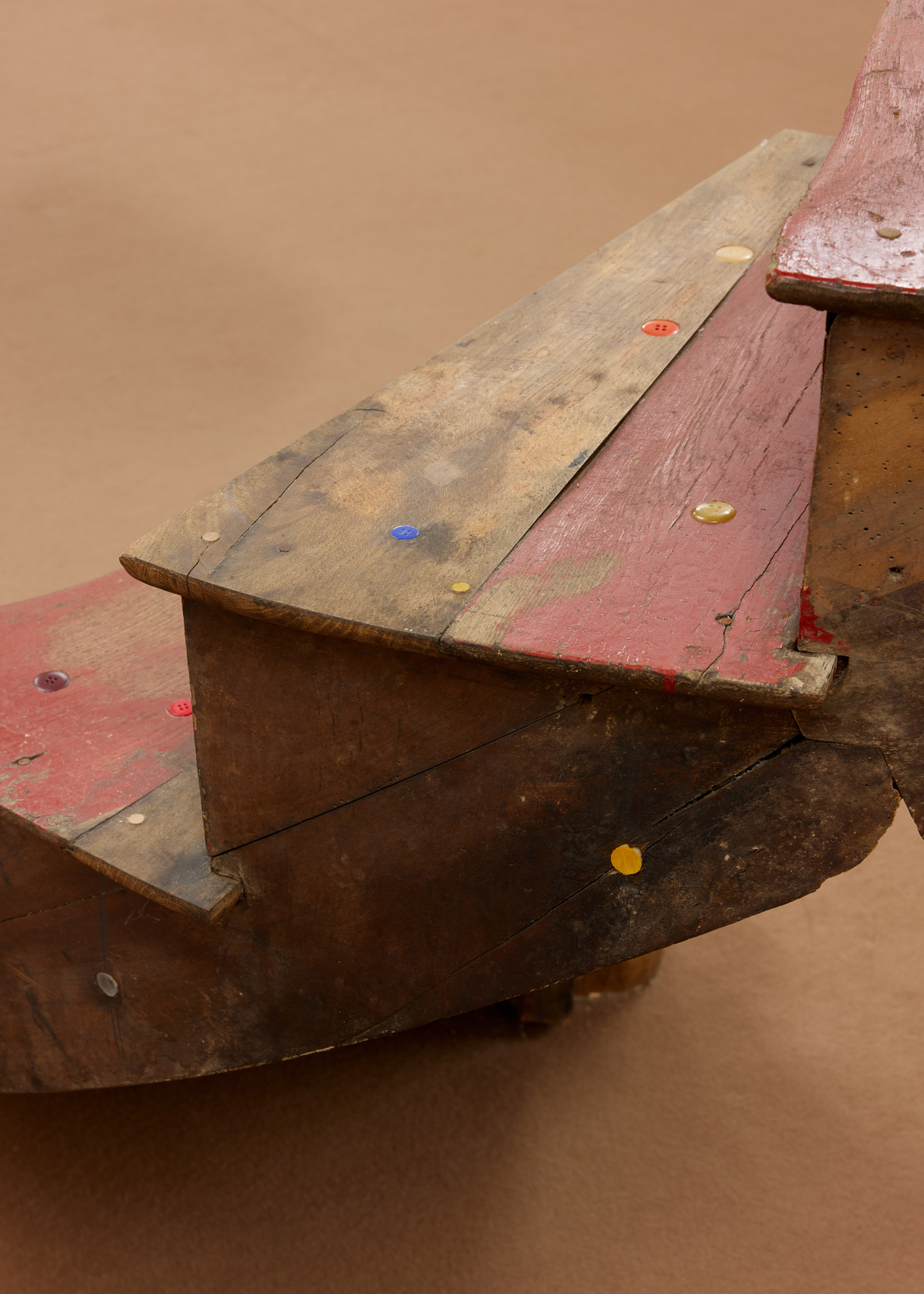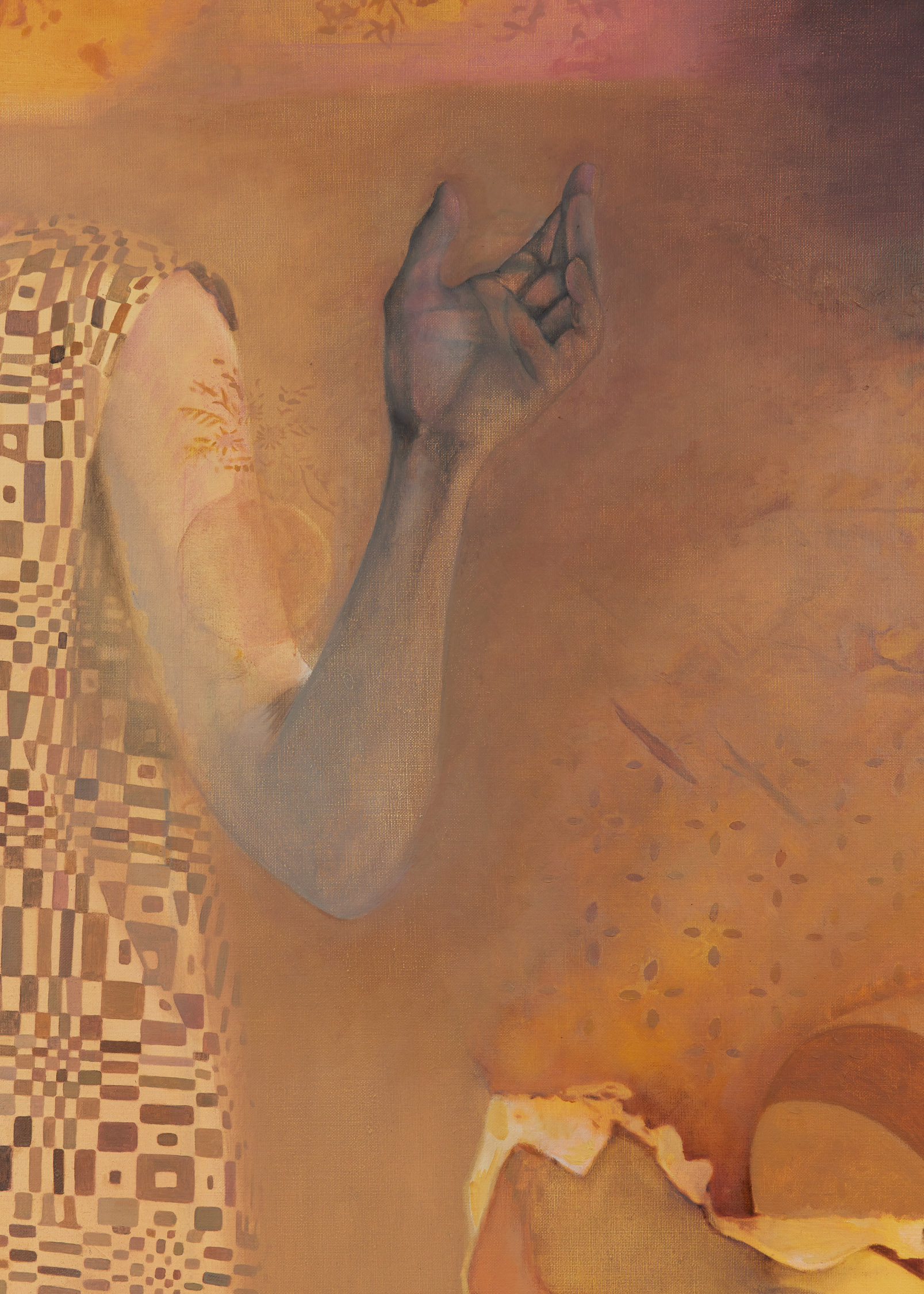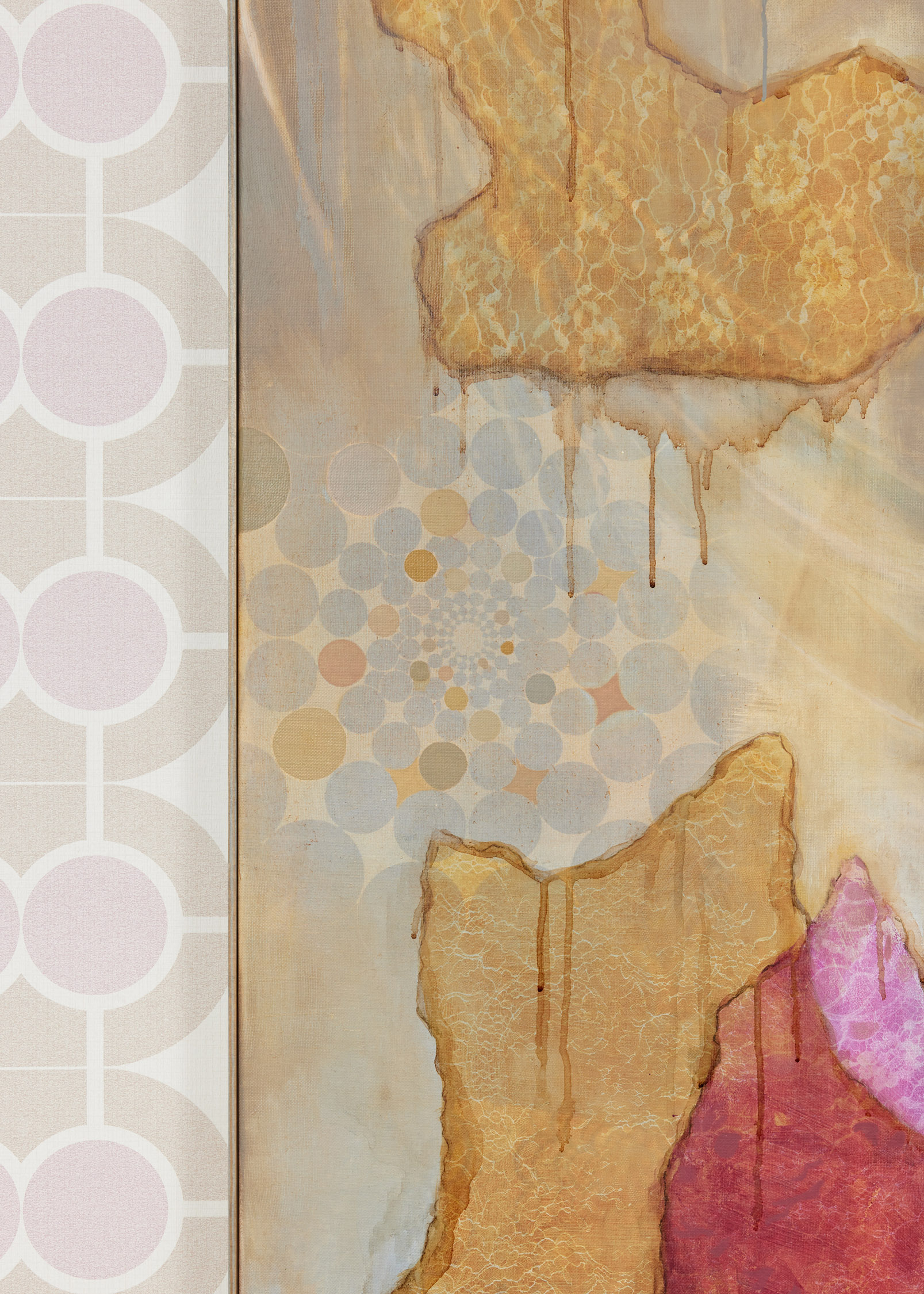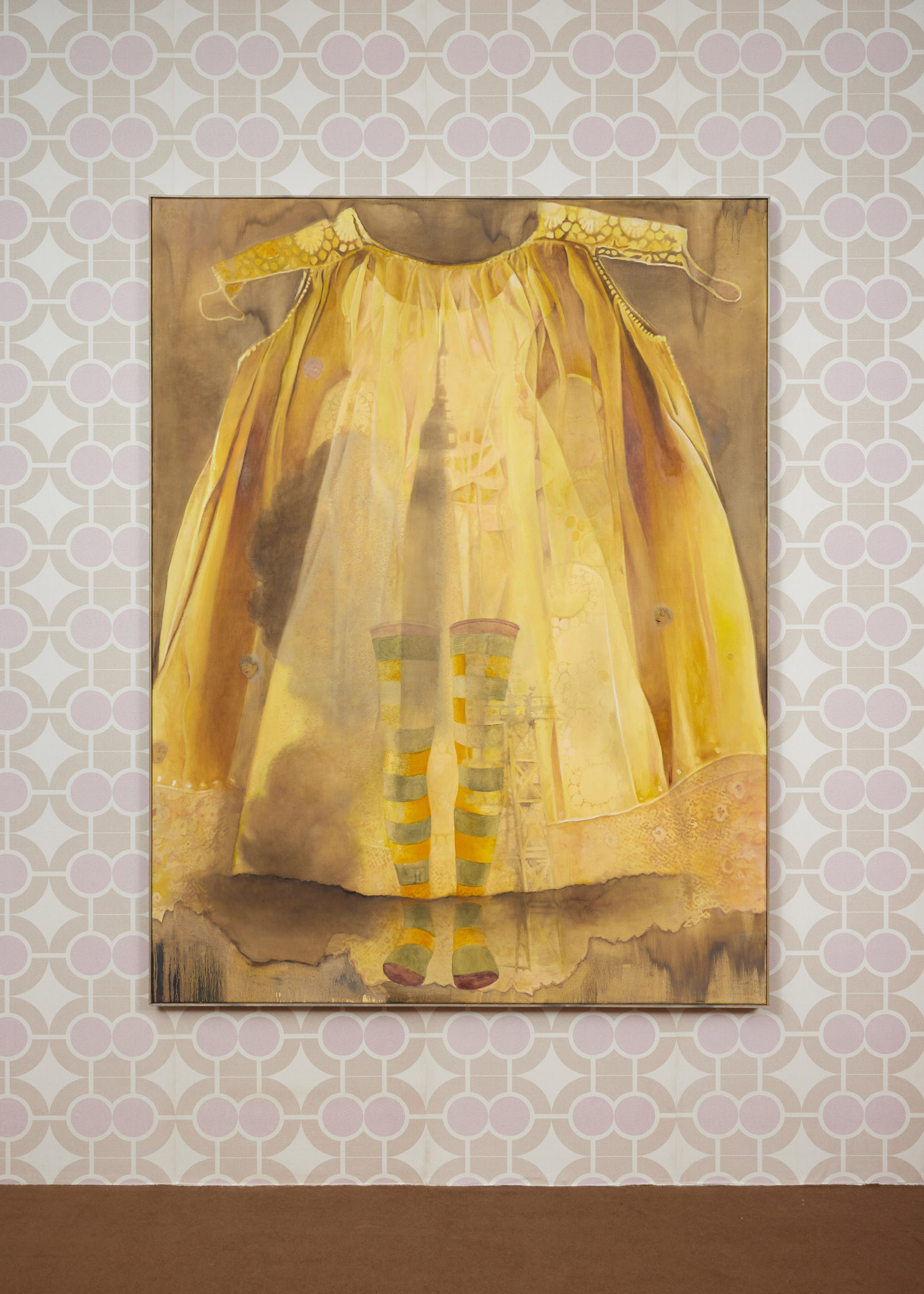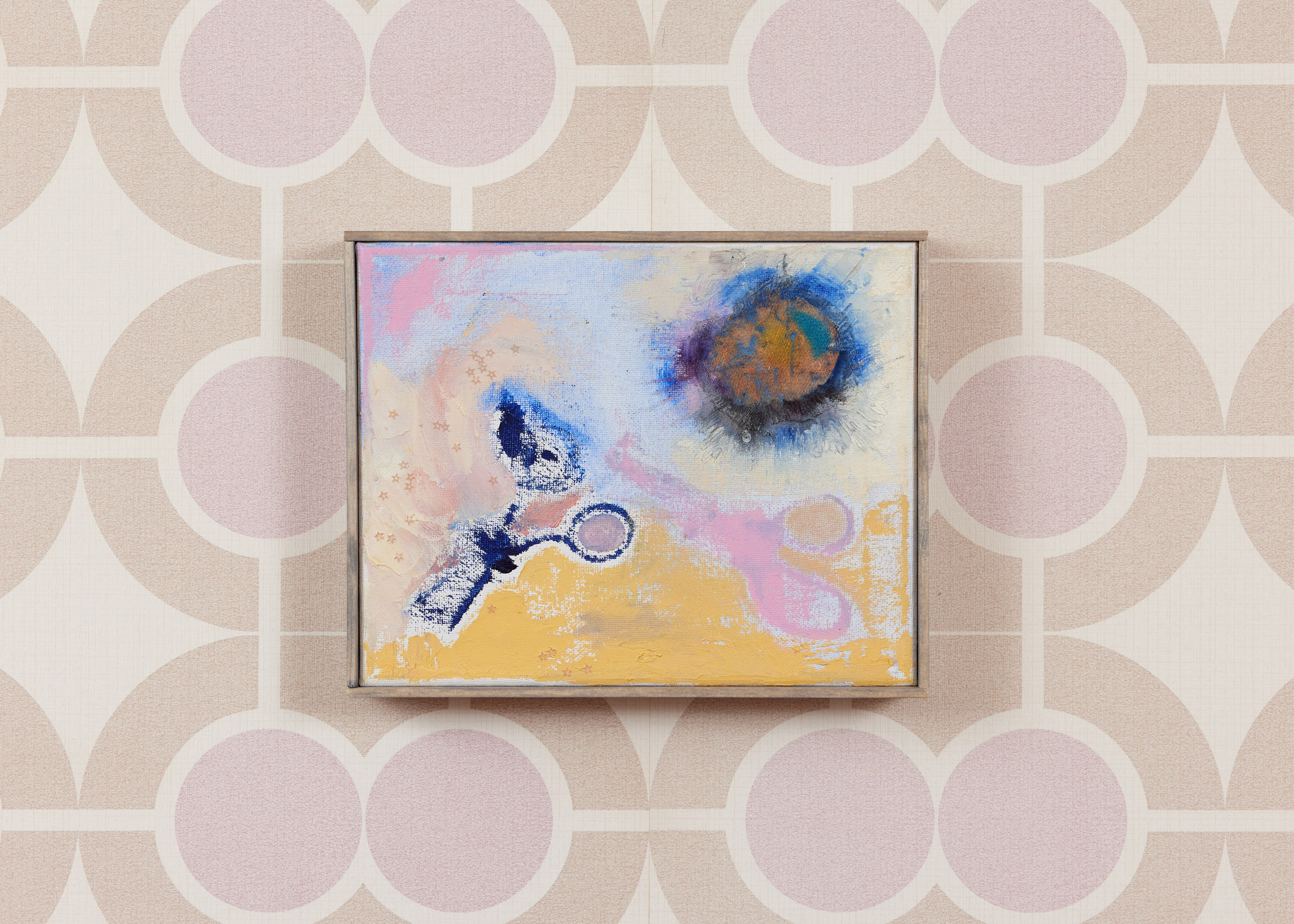Artist: Alexandra Metcalf
Exhibition title: 1st Edition
Venue: Ginny on Frederick, London, UK
Date: June 1 – July 20, 2024
Photography: all images copyright and courtesy of the artist and Ginny on Frederick, London
In 1st Edition Alexandra Metcalf fills the gallery with densely patterned wallpaper and an antique spiral staircase punctured with buttons like some kind of embedded breadcrumb trail. These elements provide a frame or backdrop for a new series of paintings. The space is both immersive and repellent. The steps invite us to imagine something beyond our reach, a hidden abode above accessible only via an undulating and spiralling ascent out of control. The wallpaper with its dizzying repetition feels somewhere between a soupy surface to collapse into and an ornate fence-like barrier. The effect is a kind of fearful attraction bringing to mind Charlotte Perkins-Gilman’s now infamous nineteenth-century short-story The Yellow Wallpaper (1892), which describes a woman’s psychotic breakdown while isolated within her home and her family. These corruptions of domestic sanctuary are also disruptions of the gallery, making the latent threats of neutral-seeming architectures palpable, even animate.
And yet these perversions also work historically. Centuries collapse in 1st Edition, condensing into the gothic-psychedelic contemporary of Metcalf’s paintings. These surfaces punctuate but also disrupt the sickly vertigo of the installation. Here patterns give way to paintings that act like portals offering possible escape or just transport. Figures appear rendered only through so much clothing – socks, arm warmers, dresses, nightgowns or lace veils – overlaid by patchworks of semi-opaque decorative symbols, stripped trees, haunted architectures and decoupaged images of diva and infant faces. These accumulations of imagery co-exist seemingly suspended in an atmosphere of rich pinks, yellows and purples – keyed to the tone of sepia. It’s all colour, no neutrality. Saturated rather than fresh. Form subservient to the veils of hue and shade.
In part, the starting point for the paintings were the 1960s phenomenon of the paper dress, specifically the American designer Harry Gordon’s’ ‘poster dresses’. Cut into an A-line pinafore, these dresses were patterned by blown-up photographs of the lip-like petals of a blooming rose, a heavily-kohled eye, a pussycat or a blasting rocket – icons of innuendo. Made for girls and young women to keep up with the ever-quickening pace of fashion at a lower cost, the selling point of Gordon’s dresses was that they could be pinned to the wall as posters as well. In Metcalf’s paintings, these poster forms appear within the deep archaeology of image and motif – rocket taking off from between two striped socks, or rose petals serving as stratification for an introvert pose.
Throwaway as in risqué and rippable – distinct from the exploitation of contemporary ‘fast fashion’ – the paper dress was an invention tied to the mid-twentieth-century emergence of the teenager, at a moment of profound transition in lives of women and girls that would only be formalised into a political struggle in the 1970s. The frivolous paper dress, on a continuum from the fangirl poster, matured into the dungarees, jeans and leather jackets of women’s liberationist style. And this shift in costume from soft to hard paralleled a new intimacy between women, where polished and reflective social facades effervesced into soft cascades of personal confessions from which a feminist politics was hewn. Surfaces shifted from the impenetrable containers of The Yellow Wallpaper, or the winding steps of the staircase, to reveal, like so many veils, a plethora of feeling – anger, joy, desire, anxiety, love. Metcalf’s atmospheric surfaces thematise the effect, in which soft but strong colour spills through and saturates image and form.
Nonetheless, the figures in Metcalf’s paintings are hardly armoured activists. Their loping forms with striped stockings and scrunched up layers are reminiscent of goth girls. All Victoriana and witchiness, this painted girliness presents a stony countenance that allows the uncomfortable force of emotional feeling and passion, characteristic of the goth, to surface. As a genre, the Gothic has long been understood as a staging of the intensities of love and horror that drive life. The high drama of the gothic is a magnification of what is otherwise and normatively repressed, or grown out of. As Eve Kosofsky Sedgwick wrote of the conventions of Gothic literature, the point is often less about the narrative, than about the interplay of characters, who do not so much plumb hidden depths, than let their feelings play out contagiously across surfaces. We see this in Metcalf’s paintings in which multiple references appear rather than recede into a repressive abyss. All that is strange and obscure bursts forth, jagged forms of feminine expression and fervour breaking through on waves of colour. For Sedgwick, such form had implications for how Gothic characters appeared on the page and consequently how their intense desires constructed a sexuality and being in the world. She wrote: ‘The self expressed or explored by these conventions is all surface, but its perimeter is neither fixed nor obvious: the veil? the countenance? The heart? This self is at least potentially social, since its “character” seems to be impressed on it from outside and to be displayed facing outward’.1 There is a certain credulity and bravery in letting all this off-putting feeling, all this displaced and misdiagnosed hysteria at the centre of things.
Metcalf’s psychedelic gothic offers no psychic resolution. Kosofsky Sedgwick’s later discussion of the Gothic, in her pioneering work of queer theory Between Men, argues that the literary genre combined the freedoms of decadence as well as articulating social prohibitions on sexuality and desire beyond the family.2 If the lackadaisical and scandalous Gothic literature of the nineteenth century thematised corrupting homosocial relations and the feminisation of the anti-work upper classes, then Metcalf’s paintings give us the goth in girly mode, riven with lassitude and too-deep bonds between peers and animal friends. In these paintings, we might imagine Bertha Rochester – the so-called ‘mad woman in the attic’ in Charlotte Bronte’s Jane Eyre (1847)– and the titular character being drawn into conspiratorial closeness, with Perkins-Gilman’s heroine. Their hysteric poses reinterpreted as some version of The Twist, locked into the always-becoming intensity of girlhood even when decoupaged with centuries-old lace and all the apparently bad-taste sentimentality of the decorative.
The goth girl is a sensibility accessible to anyone with an ounce of fury, anyone maladjusted to the world. Johanna Hedva writes of the joy of seeing ‘young goths and punks sitting in piles of each other’ smoking ‘clove cigarettes in their Dr Martens and writing lyrics on their fragile skin in ballpoint pen’, romanticising their acrimony, translating it into pure mysticism, a form of ecstatic release at limits.3 So what if a painting surface isn’t a limit but a suspension, that spills beyond its edges into an installation and its toxic seeming wallpaper that might take you deep inside itself, or its narrow, nauseating staircase that forces us out of habit and into the morphological strangeness of our bodies in space? Could this be a state of ecstasy? Or, 1st Edition’s mysterious mysticism?
– Amy Tobin
[1] Eve Kosofsky Sedgwick, ‘The Character in the Veil: Imagery of the Surface in the Gothic Novel’, PMLA, vol. 96, no. 2 (March 1981): 255–270 (261).
[2] Eve Kosofsky Sedgwick, Between Men: English Literature and Male Homosexual Desire, (New York: Columbia University Press, 1985): 83–96.
[3] Johanna Hedva, ‘They’re Really Close to My Body: A Hagiography of Nine Inch Nails and Their Resident Mystic Robin Finck’, The White Review, (March 2020) https://www.thewhitereview.org/feature/theyre-really-close-to-my-body/.
Alexandra Metcalf (b. 1992) graduated from the Chelsea College of Art and Design, London and Rhode Island School of Design, Providence. Her work has recently been exhibited at Capitan Petzel, Berlin; 15 Orient Gallery, New York; Kunsthalle Zürich; Champ Lacombe, Biarritz; Fitzpatrick Gallery, Paris; LOMEX, New York; and Ginny on Frederick, London. Metcalf’s work is held in The Museum of Modern Art Library Collection, New York; The Perry and Marty Granoff Center for the Creative Arts, Brown University, Providence and The Perimeter, London.


